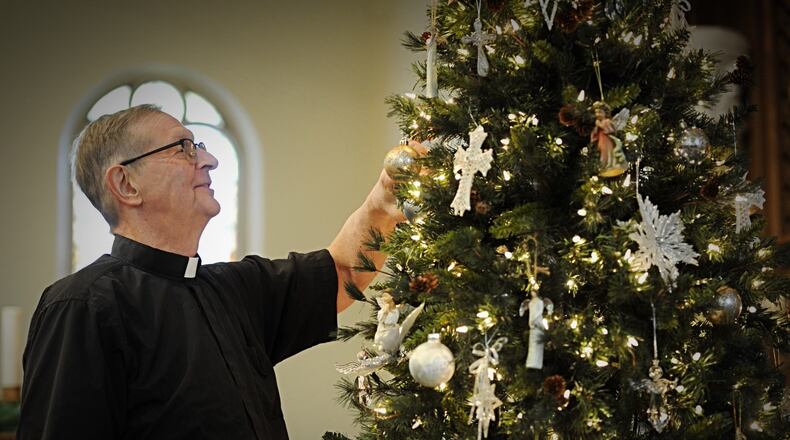“You just have to shift your message, and isn’t that what the church has always done?” asked the Rev. Dan Clemens of First Baptist Church of Hamilton. “Whatever the environment is, we just have to continue to find a way to share God’s love with people.”
St. John’s Evangelical Lutheran Church in Springfield has fared unexpectedly well financially, Pastor John Pollock said. Although attendance has significantly declined, he said church members continued to give generously. The church has not had to cutback on any of its programs, although there’s a shortage in volunteers, he said.
Prior to the pandemic, Pastor John Pollock of St. John’s Evangelical Lutheran Church in Springfield said his church averaged about 120 people on Sundays. It now averages half that amount, in a building built for 200 to 300 people, he said.
“With the congregation now, attendance is less,” he said. “There’s plenty of room for social distancing. It’s not like churches are packed every Sunday.”
Many churches in the region have held in-person services the majority of this year. Others such as Wayman A.M.E. Church in Dayton opted to live stream all of its worship services. When the weather was warm, worship services were held in the church’s parking lot, although people remained in their cars, said Gerald Cooper, Wayman’s pastor.
The decision to have remote services was made out of an abundance of caution for the congregation, he said, some of whom are elderly.
“Different churches have to make their own decisions, but we felt very strongly that we wanted to do what was in the best interest of the congregation,” Cooper said.
St. John’s and other area churches, including SouthBrook Christian Church in Miamisburg, First Baptist Church of Hamilton, and St. Luke Catholic Church in Beavercreek, have had a combination of in-person and virtual services. They all say they have safety protocols in place, and social distancing is enforced.
SouthBrook, with a congregation of more than 3,000 people, has averaged 30% capacity, or 800 people, between two Sunday services this year, said Leah Sparling, director of City Lights, the church’s charitable arm.
St. Luke in Beavercreek can hold more than 1,200 per service. But it has averaged up to 180 people per mass, said Deacon Bill LeCain. The church follows the Archdiocese’s coronavirus protocol that allows them continue such traditions as communion and confession.
The decline in attendance forced many churches to embrace technology and social media to continue getting their message out.
Prior to the pandemic, churches such as St. John’s, Wayman, and First Baptist Church of Hamilton did not livestream services. But they pivoted and have been streaming on Facebook and other social media platforms. First Baptist purchased airtime on the radio to broadcast services, Clemons said.
SouthBrook has always streamed its services, but when the pandemic came, they stepped up those efforts, producing videos and short stories that people could watch at anytime. In addition, pastors chat online with people, Sparling said,
The churches have also turned to technology to allow members to tithe, and in some case, electronic giving has significantly increased.
“There’re a number of people who say now that they see how easy it is to (give electronically), they don’t plan on going back to the old way,” said Cooper, noting that there are a handful who still travel to the church to drop off their donation envelop.
In general, churches said giving is noticeably down this year because of the reduction in the number of people attending worship services. However, none has had to make drastic cuts to staff or services because of good investments and strong bookkeeping.
“We have a good financial committee; we kept our heads above water,” said LeCain of St. Luke.
The decline in giving has not deterred churches from helping people in need; it’s forced them to change their approaches. Wayman AME canceled its annual community festival in August, as well as its holiday basket giveaways. Instead, church members have given families gift cards, Cooper said.
Similarly, First Baptist distributed Kroger gift cards to families in Hamilton. The church’s weekly Saturday morning feeding program, which used to be a hot, sit-down meal, is now carryout, Clemens said.
St. John’s did not cut back on its weekly hot meals, but attendance has been surprisingly down, Pollock said. Prior to the pandemic, the church fed 170 people per week. Now thy barely get 100, he said. Fewer people have visited its food pantry as well.
Based on information St. John’s gets from the county, people in town are in need, so it’s puzzling as to why they aren’t coming.
“The only thig I can figure out is for some reason people are leery about coming because of the pandemic,” he said.
The COVID-19 pandemic has caused SouthBrook to increase its community outreach, Sparling said. Through the City Lights organization, launched in February, SouthBrook is doing more for the community this year than it has in previous years, she said. It’s also become more proactive ― as opposed to reactive ― in terms of helping the needy, she said.
“There’s an urgency,” Sparling said. “People have lost their jobs and lost their livelihoods, their income, they’re hungry, they’re tired. So we are not going to be one of those churches that just hunker down and wait for this to be over.”
About the Author
